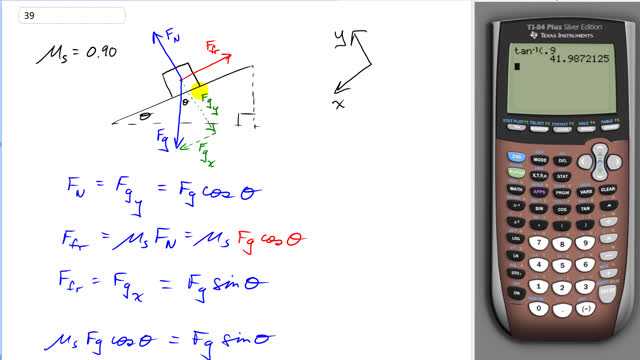
The coefficient of static friction between hard rubber and normal street pavement is about 0.90. On how steep a hill (maximum angle) can you leave a car parked?

In order to watch this solution you need to have a subscription.
This is Giancoli Answers with Mr. Dychko. This car is parked on a hill and we want to find the maximum angle that could have so that doesn't slide. Now, if the car is not moving, that means this component of gravity in the y direction equals the normal force because it's not going off the hill or into the hill. And also, this friction force which is due to a static friction directed up the hill is equal to the component of gravity that's pulling it down the hill. And we have our coordinate system on an angle like that with the x axis going down the hill positive and y axis going perpendicular to the hill. So, with the first we'll figure out the normal force and then use that to calculate the static friction force. And then we'll say that the static friction force equals the component of gravity down the ramp and then we'll find an expression for that from this triangle. And then we can equate this and this and we'll solve for the angle. OK. One step at a time, though. So, the normal force is a component of gravity in the y direction or perpendicular to the hill and that would be the... Well, since this is the angle of incline, and this angle in here in this gravity triangle is the same as the incline angle. Then that means this is the adjacent leg of the triangle, and so, we use cosine to find what the component of the gravity is in the y direction and that equals the normal force. And then to... Well, the friction force is the coefficient of static friction times the normal force, and so, it's muS times Fg cos theta. Substituting for the normal force there. And then the friction force has to equal the component of gravity in the x direction in order for the car to not be accelerating along the hill, up or down. And the component of gravity directed along the hill is the opposite leg of this triangle. So, you use force of gravity times sine theta to get that leg of the triangle. And since this friction force equals the component of gravity we can say that muS Fg cos theta equals Fg sine theta. And now we solve for theta. We know that we can divide both sides by Fg so that term disappears. And then divide both sides by cos theta. And we get muS equals sine theta divided by cos theta. And the reason this is useful is because we can express the single thing, the single fraction as tan theta. That's just something you have to memorize, that sine theta divided by cos theta is always tan theta. So, we have tan theta equals muS then. And so, if theta is the inverse tangent of the coefficient of static friction of 0.9 which gives 42 degrees, is the maximum angle you could possibly have here to avoid sliding down the hill.